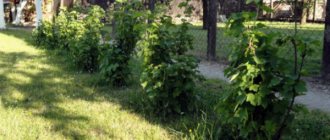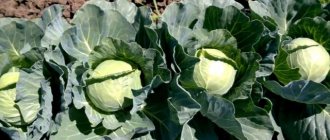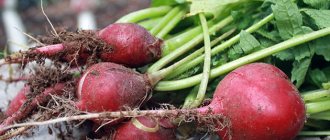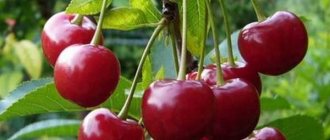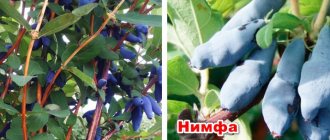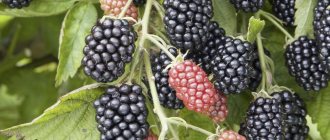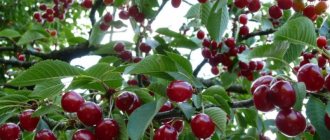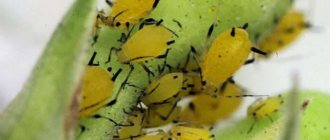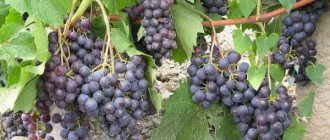Ezhemalina appeared in America at the end of the 19th century. The first version of the berry crop, called the annual berry crop, was the result of an accidental crossing of its ancestors - raspberries and blackberries (the bushes grew side by side in the garden). The experiments of scientists that followed the discovery became the beginning of the appearance of original fruits.
Hybrids combined the best properties of the prototypes. From raspberries the crop received a small number of thorns and frost resistance, from blackberries it received unpretentiousness and resistance to disease. In some countries, the berry is grown on an industrial scale. In our country it is still rare, diluting the usual plantings. Having decided to grow an unusual crop, it is worth studying the main characteristics of the varieties, getting acquainted with photos and reviews about Ezhmalina.
General characteristics of the hybrid
Not everyone knows what Ezhemalina is. Therefore, it is so important to study the characteristics of the culture, the rules of breeding and care, in order to then give yourself the pleasure of enjoying the piquant taste of unusual fruits.
The first to become known was Loganberry, which appeared due to an accidental crossing of two bushes growing nearby in the garden of a Californian judge. This story was not ignored by scientists, and their subsequent experiments gave impetus to breeders to create a completely new berry crop.
Loganberry - the first blackberry-raspberry hybrid
The description of the Ezhmalina Loganberry variety can be represented by the following characteristics:
- the bush produces large fruits and is famous for its large harvests;
- the culture is unpretentious to care;
- produces fairly long shoots compared to prototypes;
- raspberry blackberries are more resistant to frost;
- the fruits have absorbed all the beneficial properties of related crops.
All other features of the plant (direction of branch growth, number of replacement shoots, weight and color of fruits) are relative and each variety has its own.
True, raspberries also transmitted their diseases to the culture, but Loganberry blackberries have higher immunity. The taste of the berries is slightly inferior to their predecessors, but this is more than compensated for by other advantages.
Productivity
Blackberry raspberries bloom in the first half of May, and already in mid-June you can harvest. The fruiting period itself lasts an average of a month. The number of berries taken directly depends on the age of the bush - everything is increasing.
Starting from the second year after planting, few fruits appear on the plant; they are not as large as the gardener expected. But every year their number on the branches increases, and they are actively gaining mass. From a three-year-old bush it will be possible to take an average of 5-6 kg and at least 12 tons per hectare.
Care
Having understood how to plant raspberries, they study the features of caring for the crop. No new technologies are required here - all the work is already familiar to summer residents.
Watering
Remontant raspberries: the best varieties for Siberia
In terms of humidity, this crop is not as demanding as raspberries, but you will have to irrigate the plant periodically. The first watering is carried out immediately after planting the seedlings. A water procedure is required a couple of days after circumcision. If the summer is hot and without rain, then it is advisable to moisten the soil during the ripening of the berries.
Feeding
In the first year, plants should not be saturated with fertilizers - the humus that was added during planting will be enough for them to take root. In the future, the bushes are fed every 2-3 years. For this purpose, manure and phosphorus-potassium fertilizers are used. Their quantity per bush is selected taking into account the fertility of the soil.
Bush formation
Particular attention should be paid to pruning the raspberries - the entire harvest depends on it. The main work is carried out after the end of the fruiting period or in the fall, but long before the onset of severe frosts. Remove old, broken, diseased shoots and excess growth.
Spring sanitary treatment of the bushes will also be required. Remove those that did not survive the winter well. From the remaining ones, several high-quality branches are selected that will participate in fruiting, and the rest must be pruned.
Note! One of the stages of formation is pinching the tops of the current year's shoots. This will increase their branching, which will have a positive effect on the future harvest.
Trellis
Any variety of raspberry grows long stems. Some of them will grow straight, others will spread, like blackberries, so you can’t do without reliable support. A garter will help the bushes develop better and give ultraviolet light access to the berries.
Preparation of the trellis
Since the fruits are large and there are many of them on the branches, the stems cannot withstand such a load. Therefore, the trellis must be strong enough. For support, either metal poles or strong thick beams with a height of at least 2.5 m should be used.
You will need a strong nylon fishing line or thick wire, which is pulled evenly in 5 rows. Fruit bearings are secured on the upper tiers by tying them with a snake, and replacement stems are placed on the lower tiers.
Preparing for winter
The resistance of the hybrid to frost depends on the variety, but in the middle zone and northern regions it is impossible to do without shelter. To begin with, the plants need to be pruned, completely removing the shoots that have spawned.
The remaining branches may break off under the weight of snow, so it is recommended to bend them to the ground, carefully removing them from the trellis with your hands. For convenience, first bend the tops of the stems, securing them to the ground with a small weight. Then the entire shoot is gently lowered.
Preparing for winter
The laid branches are covered with shavings, sawdust, straw, and spruce paws. If necessary, use roofing felt, spunbond or other similar material if a harsh winter is expected.
Reproduction of raspberries
It is better to propagate a hybrid crop vegetatively, since the use of seeds will not only extend the process over a long period, but will also not allow preserving the varietal characteristics of the bush.
Tayberry variety
Below is a description of the features of how propagation by cuttings is carried out.
Cutting propagation of raspberries
| Cuttings | Features of reproduction |
| Greens | Harvesting is done in the summer (usually in August), cutting off the tops by 30-35 cm. They are immediately laid horizontally in small trenches up to 20 cm deep and covered with earth. Next year, one cutting can grow up to 4 small bushes that need to be planted in new places |
| Lignified | In autumn, shoots of the current year on which at least 4 buds have formed are selected as planting material. These stems are cut and kept in a container with water for a day. When planting cuttings in open ground, gaps of 5-10 cm are made between them. They are buried in the ground in such a way that only 2 buds remain on the surface. If after watering the rest are exposed, they are buried in soil. |
| Root | In the spring, after digging up the bush, they get to the roots. Select those that have a thickness of at least 7 mm. They are cut off, and the bush is buried again with earth. The root is dissected into 15 cm cuttings and buried in the ground to a depth of about 20 cm |
Reproduction using cuttings allows you to have well-developed seedlings within a year. At the same time, all the characteristics of the mother bush are passed on to the children.
Cuttings of raspberries
Diseases and pests
When caring for raspberries, do not forget about the health of the bush. The hybrid inherited from raspberries a predisposition to diseases such as rust, powdery mildew, verticillium, anthracnose, etc. Therefore, it is necessary to keep fungicides on hand.
Many modern varieties of raspberry easily cope with these diseases. Thus, Loganberry blackberries have developed immunity to verticulosis and mildew, while Boynesberry blackberries are affected by them. With regard to rust, the situation is the opposite.
As for pests, the berry garden is visited by the following insects: galitza, crimson beetle, and weevil. But knowing how to properly care for raspberries, this misfortune can be avoided.
Note! It is important to prevent thickening of plantings, to mulch the soil in a timely manner and to apply preventive measures.
Planting a plant
Blackberries and raspberries are related crops, so their agricultural practices are similar. The same applies to the hybrid. But beginners in gardening should still pay attention to the question of how to plant raspberries in the spring. Although some prefer to do this in the fall, this option is only suitable for the southern regions.
Note! In the northern regions and Moscow, seedlings may not have time to take root before frost.
Despite the unpretentiousness of the raspberry plant, planting and caring for it must be carried out according to all the rules. First of all, you should pay attention to the roots of the seedlings. It is advisable that they be with a lump of earth. If the system is open, then the rhizomes should not be dry and painful. If the sprouts already have vegetative buds, try not to damage them when planting.
For raspberries, you should choose a spacious, sunny area - in cramped spaces and shade, the plants will produce a weak harvest. When breaking up a berry garden, they choose an ordinary planting method. In this case, for each bush you will need a square hole 40 cm wide and with the same depth. The seedlings are placed at a distance of a meter from each other, maintaining a row spacing of one and a half to two meters, so that in the future the adult bush does not interfere with its neighbors.
A few weeks before planting, the holes are prepared. The soil extracted from them is mixed with humus (not manure or droppings!), and half of this mixture is returned to the pits. Having lowered the seedlings into the hole, sprinkle the plant with the remaining soil, compact it well, water and mulch. Here you can already use mullein, sawdust with ash, and even weeded weeds.
Having understood how to plant raspberries, they study the features of caring for the crop. No new technologies are required here - all the work is already familiar to summer residents.
Watering
In terms of humidity, this crop is not as demanding as raspberries, but you will have to irrigate the plant periodically. The first watering is carried out immediately after planting the seedlings. A water procedure is required a couple of days after circumcision. If the summer is hot and without rain, then it is advisable to moisten the soil during the ripening of the berries.
Feeding
In the first year, plants should not be saturated with fertilizers - the humus that was added during planting will be enough for them to take root. In the future, the bushes are fed every 2-3 years. For this purpose, manure and phosphorus-potassium fertilizers are used. Their quantity per bush is selected taking into account the fertility of the soil.
Bush formation
Particular attention should be paid to pruning the raspberries - the entire harvest depends on it. The main work is carried out after the end of the fruiting period or in the fall, but long before the onset of severe frosts. Remove old, broken, diseased shoots and excess growth.
Spring sanitary treatment of the bushes will also be required. Remove those that did not survive the winter well. From the remaining ones, several high-quality branches are selected that will participate in fruiting, and the rest must be pruned.
Note! One of the stages of formation is pinching the tops of the current year's shoots. This will increase their branching, which will have a positive effect on the future harvest.
Trellis
Any variety of raspberry grows long stems. Some of them will grow straight, others will spread, like blackberries, so you can’t do without reliable support. A garter will help the bushes develop better and give ultraviolet light access to the berries.
Since the fruits are large and there are many of them on the branches, the stems cannot withstand such a load. Therefore, the trellis must be strong enough. For support, either metal poles or strong thick beams with a height of at least 2.5 m should be used.
You will need a strong nylon fishing line or thick wire, which is pulled evenly in 5 rows. Fruit bearings are secured on the upper tiers by tying them with a snake, and replacement stems are placed on the lower tiers.
Preparing for winter
The resistance of the hybrid to frost depends on the variety, but in the middle zone and northern regions it is impossible to do without shelter. To begin with, the plants need to be pruned, completely removing the shoots that have spawned.
The remaining branches may break off under the weight of snow, so it is recommended to bend them to the ground, carefully removing them from the trellis with your hands. For convenience, first bend the tops of the stems, securing them to the ground with a small weight. Then the entire shoot is gently lowered.
Preparing for winter
The laid branches are covered with shavings, sawdust, straw, and spruce paws. If necessary, use roofing felt, spunbond or other similar material if a harsh winter is expected.
Reproduction of raspberries
It is better to propagate a hybrid crop vegetatively, since the use of seeds will not only extend the process over a long period, but will also not allow preserving the varietal characteristics of the bush.
Below is a description of the features of how propagation by cuttings is carried out.
Cutting propagation of raspberries
| Cuttings | Features of reproduction |
| Greens | Harvesting is done in the summer (usually in August), cutting off the tops by 30-35 cm. They are immediately laid horizontally in small trenches up to 20 cm deep and covered with earth. Next year, one cutting can grow up to 4 small bushes that need to be planted in new places |
| Lignified | In autumn, shoots of the current year on which at least 4 buds have formed are selected as planting material. These stems are cut and kept in a container with water for a day. When planting cuttings in open ground, gaps of 5-10 cm are made between them. They are buried in the ground in such a way that only 2 buds remain on the surface. If after watering the rest are exposed, they are buried in soil. |
| Root | In the spring, after digging up the bush, they get to the roots. Select those that have a thickness of at least 7 mm. They are cut off, and the bush is buried again with earth. The root is dissected into 15 cm cuttings and buried in the ground to a depth of about 20 cm |
Reproduction using cuttings allows you to have well-developed seedlings within a year. At the same time, all the characteristics of the mother bush are passed on to the children.
Raspberry care
Regardless of the variety, caring for this plant will not cause you any particular difficulties. It is important to adhere to several rules.
Watering
Ezhemalina is less demanding on watering than, for example, raspberries. Watering is required at the planting stage, and also after 2 weeks, when the seedlings have taken root. It needs abundant watering when the berries form and ripen. If the weather is dry for a long time, the gardener may be required to provide additional watering. If it rains in the summer, even if not often, but regularly, this will be quite enough.
Top dressing
Do not rush to apply fertilizers. Experienced gardeners recommend doing this no earlier than 2 years after planting the plant and then once every 2-3 years. There are no special requirements for raspberries; the same fertilizers are used as for raspberry bushes. What can be used as fertilizer:
- Manure - 3-5 kg per 1 square meter.
- Potash or phosphate fertilizers - 2 kg of double superphosphate, 2 kg of potassium sulfate or 5 kg of simple superphosphate per 100 square meters.
This is not an exact dosage and may vary depending on the type of soil in which the crop is planted.
Trimming
A prerequisite for caring for raspberries is the formation of bushes , since the yield of the plant depends on this. There are several opinions on when exactly pruning should be done. Some gardeners say that the best period will be late autumn, others advise pruning after the bush finishes bearing fruit. Considering that different varieties have different periods of fruit ripening, both of these opinions can be considered correct.
It is best to prune before the onset of severe frost. It is necessary to remove old, dried and damaged shoots. Pruning can also be done in the spring; this is not prohibited. The only important rule in this case is to start pruning before the sap begins to flow. It is also necessary to pinch the top of the bush, this will allow them to grow well.
Garter
Most varieties of raspberries grow well, their berries are large and the shoots simply bend under their weight. To do this, it is recommended to tie up the plants, namely to grow them on a trellis. If this is not done, the bush will spread over time and the berries will become smaller. You can make it in several layers and quite high, 2-3 meters. To do this, you will need wire or nylon fishing line; they should be pulled in 5 layers. The shoots that bear fruit are tied to the upper layers, the rest are fixed to the lower ones. You can fasten it with a snake.
This procedure will promote good growth of the bush, and thanks to the garter of fruitful shoots, they will receive enough sunlight.
Reproduction
Reproduction occurs by vegetative method. Let's take a closer look at how to propagate Ezhmalina:
- Green cuttings . Such branches are harvested in August. 20-40 centimeters are trimmed from the tops, then they are planted in the ground (about 20 cm). Next year, from 1 such shoot you can get up to 4 independent plants.
- Lignified cuttings . Harvested in the fall, cut branches 20 cm long, which have at least 2 buds. Afterwards, they are soaked in water for a day and planted in the ground to a depth of 20 cm. The distance between them should be 5-10 cm, and no more than 2 buds should remain on the surface. If additional buds appear during the germination process, they are sprinkled with earth.
- Root cuttings . This procedure is carried out in the spring. The plant is dug up, the roots are divided into parts and planted in the ground to a depth of about 20 cm.
Interesting fact! When propagated by seeds, raspberry does not retain the varietal properties of its “parents”.
Shelter for the winter
Most varieties have good cold resistance and will not require this procedure. However, there are varieties that in the first years need shelter for the winter. To do this, you will need to untie all the branches from the trellises and carefully lay them along the supports. If the growing region requires little snow in the winter, you can use peat, sawdust, straw, and fallen leaves for shelter. In regions with snowy winters, snow will do just fine as a shelter. It will protect the shoots from freezing.
Diseases and pests
This hybrid is quite resistant to diseases, but sometimes it can be affected by the same diseases as regular raspberries. And in particular:
- rust;
- powdery mildew;
- verticillium wilt.
When controlling the disease, it is recommended to use fungicides, but it is important to finish using them at least 20 days before harvest.
Pests of shrubs include weevils, galitsa, and raspberry beetles. To avoid pest damage to the plant, you should maintain planting density, mulch the soil and not neglect the rules of care.
Varieties of raspberries
Despite the fact that the raspberry-blackberry hybrid appeared relatively recently, breeders have already developed a large number of varieties of the crop. Many of them immediately became popular among summer residents. Therefore, it is worth considering the best of them.
Varieties of raspberries
| Name | Description |
| Boysenberry | Boysenberry blackberry can be called a variety of Loganberry crossed with blackberry. Black cherry berries reach 5 cm in length. They have a pleasant blackberry aroma and sweet taste. |
| Tayberry | The creeping shoots are densely strewn with rich red berries, reaching 4 cm. The variety is valued by gardeners for its delicate taste and ability not to fall off for a long time, firmly holding on to the stalk. A variety of this variety is the unpretentious Buckingham raspberry, which has larger berries - up to 8 cm |
| Texas | The hybrid has taken root well in the Moscow region. Its semi-ripe fruits resemble raspberries, but larger in size (up to 4 cm). By the time it is fully ripe, the berry acquires a dark purple color and becomes intensely sweet with a subtle sourness. |
| Darrow | This is a representative of an erect bush, reaching 3 meters in height. But not only for this reason the plant requires a trellis - the branches are maximally strewn with sweet scarlet-purple berries. From one bush you can take at least 10 kg per season |
| Silvan | This variety is in many ways similar to Tayberry, but produces 2 times more fruit. Silvan belongs to the early culture. In this case, the harvest stretches for a month and a half. Large (10-14 cm) tasty aromatic berries are collected in voluminous brushes |
| Cumberland | From a distance, the berry can be mistaken for a blackberry due to its deep black color. But the bush itself is significantly different - it has thick shoots arranged in an arch, covered with a thick waxy coating and powerful thorns. Gardeners value Cumberland Ezhemalina for its resistance to disease and lack of overgrowth. Due to its high frost resistance, the variety has taken root well in the northern regions. |
| Medana | A fairly early variety descended from Tybury - harvests can be harvested as early as June. Ezhemalina, whose berries reach 4 cm in length, has a sweetish candy taste. The variety is resistant to viral diseases and can withstand heat well. Requires serious shelter for the winter |
| Marion | It is a commercial variety, but is also actively grown by private owners. It is the taste qualities of large Marion berries that serve as a standard for breeders to follow when creating new varieties |
| Red Diamond | A special feature of the bush is its ability not to spread across the site. The variety attracts gardeners with its berries - almost transparent shiny rubies that shimmer beautifully under the rays of the sun. The taste of the fruit is rich, somewhat reminiscent of sweet cherries. |
| Thornless | The Loganberry variety is distinguished by its thornlessness. Raspberry-red, cone-shaped large berries without a glossy coating have a pleasant taste and unusual aroma. Large fruits are collected in clusters of 6-8 pieces |
Any of the described varieties of raspberries is worth propagating a berry plant in your garden plot. But at the same time, it is necessary to take into account the regional characteristics of the culture, then it will take root well and feel comfortable in the place chosen for it.
If the attention of novice gardeners is attracted by the daily raspberry, care and cultivation will not be hard work. It is enough to adhere to the golden rules of the farmer, and the garden crop will delight you with delicious aromatic berries every season. Having absorbed into the composition of the fruit all the most useful things from its “relatives”, every raspberry will become a good vitamin supplement to the diet.
Popular varieties of garden raspberries
The raspberry-blackberry hybrid was developed not very long ago, but gardeners grow some varieties most readily.
Tayberry is a tall plant with creeping stems. An early-ripening variety was developed by the Scottish scientist D. L. Jennings in the early 60s of the 20th century. The hybrid is the result of crossing Malling Jewel raspberries and Aurora blackberries. The branches are densely covered with scarlet berries . Delicate in taste, they are firmly attached to the stalks. The size reaches 40 mm , weight – 6 g.
Tayberry berries quickly become overripe, turning black in color. The stalks are tightly attached to the berries. The stems are spiny. In mature shrubs (over 5 years old), replacement shoots are not formed. It is successfully grown in different climatic zones. Features of cultivation:
- grows well on sandy loam soil and nutritious loam;
- choose a place in partial shade (the foliage does not cover the fruits, so in the sun they ripen very quickly, and in full shade their sweetness is lost);
- They are planted in the ground in early spring, in autumn - before frost and in summer, maintaining the integrity of the earthen coma.
Photo: Tayberry
The buckingham tayberry raspberry, obtained from tayberry, has thornless branches and fruits twice as large, but more sour. These variety forms are valued for their unpretentiousness and high fruit yield: on average, 6 berries are formed in each cluster, the productivity of the berry plant is at least 5 kg per season.
Photo: Buckingham hybrid
The early ripening Medana variety is derived from tayberry. Long burgundy shoots are dotted with small thorns. Fragrant large drupes with a caramel taste ripen in June. The length of each is up to 40 mm. Madana tolerates heat well. Good shelter is required for the winter.
Photo: Medana variety form
Video: propagation of Tayberry raspberry
Boysenberry is the result of crossing raspberries, loganberries and blackberries. Flexible long (up to 4 m) stems strongly branch and creep. There are few thorns. There are varieties without thorns. Forms root shoots in large quantities. The elongated (50 mm) fruits weigh 13 g. They are very tasty, have a blackberry-like aroma, and are dark cherry in color. They ripen in mid-July. The harvest is harvested until the end of August.
Ripe boysenberry fruits acquire a black tint and stand out beautifully against the background of light green foliage. The drupe is easily detached from the stalk. Frost resistance and fruit yield are average. Drought resistance is high. Widely used in the production of confectionery and cosmetology. Productivity and taste (sugar content) are higher than those of Tayberry. Resistant to diseases.
Video
Its main strength is its amazing taste: one of the sweetest and most aromatic in its niche, Boysenberry raspberry will amaze with intricately intertwined blackberry-raspberry notes, sweetness and elegant weightless sourness, and a bright, intense aroma.
It does not shine with yield, but there are few equal in taste qualities - if you are starting a dessert variety for yourself, you should not look further - most of those who planted it are confident in this.
But there are also many shortcomings that make it remain a blackberry for amateur collectors.
What you need to know about Boysen berry, what secrets it keeps - characteristics, description, basic care, opinions.
Description of Boysenberry, characteristics: powerful, tasty. Is it productive?
Description of Boysenberry raspberries - focusing on the main thing, characteristics.
The photo shows a raspberry-blackberry hybrid, also known as Boysenberry raspberry.
The raspberry-blackberry hybrid Boysenberry was obtained in the 30s of the XX century in the USA, bred in 1923 in California by R. Boysen - a hybrid of raspberries, blackberries and Logan berries. It is grown on industrial plantations and gardens. Its taste qualities are superior to raspberries and many cultivated varieties of blackberries and raspberries; in the USA it is traditionally grown on commercial areas for the fresh market, self-harvesting, processing, and on personal plots.
In Europe and the post-Soviet space, it is not particularly widespread; it is positioned as a crop for medium- and low-volume production or not at all commercial due to low transportability and low productivity. In general, it is used in commercial cultivation for the fresh market in small volumes, an ideal option for the garden - for those who value taste and are not chasing volume.
Ripens in late July-early August. In central Russia it begins to ripen at the end of July, compressed fruiting lasts until mid-late August, in the center and south of Ukraine - at the end of June, along with summer raspberries.
The yield in comparison with blackberries is average, at the level of raspberries. According to rough estimates, the average industrial yield is about 6-10 t/ha.
- The berries are dark cherry, almost black when fully ripe, juicy and tender. The shape is slightly elongated, rather oval. The drupe is without gloss, well adhered, and when fully ripe, comes off easily. Average weight is 10-12 g, on mature 5-6 year old plants or more. The fruits are collected in drooping clusters of 5-6 pieces, at the initial stage they are green, then turn red and take on a dark color.
- The taste is the only reason why you should plant Boysen and turn a blind eye to its shortcomings: bright, refined, a subtle interweaving of blackberry-raspberry notes, with an intense aroma, very sweet - the best in its class. So, in comparison with Tayberi, the taste and sugar content are definitely higher, as is productivity.
- A creeping bush, with enormous growth energy, practically without thorns - occasionally single thorns can be found on 2-3 m of the vine.
- Adult shoots are highly branched, very pliable, flexible and long - more than 2-4 m, do not need pinching. Strong but flexible, they can be easily removed from the trellis and placed under cover for the winter. Small spines can be observed on the laterals - not spiny, but clinging.
- The flowers are white, medium in size.
- Produces many measles offspring. Replacement shoots are numerous, round in cross-section, powerful, green at the initial stage of development, then take on a reddish tint.
- The leaves are light green, pinnate, symmetrical, toothed, pointed.
- Winter hardiness is moderate, like all representatives of this crop; plants overwinter under cover in almost all regions of Russia, Ukraine, and Belarus.
The photo shows Boysenberry blackberries at different stages of ripening - red, turning purple and dark cherry, almost black.
- Dessert taste, unsurpassed aroma;
- Excellent quality of fruits - ideal shape, uniform, large;
- Powerful growth force, abundant lateral branching, supple long vines - the ability to grow without pinching, which makes care easier;
- Unpretentiousness, disease resistance at the level of analogues;
- Unlike many raspberry-blackberry hybrids, the seedlings take root well and have a high survival rate.
- The fruits are very large, but not numerous;
- Too juicy and tender berries are not particularly transportable;
- Low winter hardiness - if the shelter is unreliable, fruit buds and vines may freeze;
- If the root is damaged, it can produce prickly root shoots;
- Moderate yield - lower than some analogues, at the level of raspberries.
Care: how to grow wisely
Caring for raspberries differs from the agricultural technology for growing other berries, and each hybrid has its own characteristics. Boysenberry is no exception - cultivation, key points of care.
Varieties of raspberries
Taybery
This is the most popular variety. Obtained as a result of crossing the blackberry Morus nigra and the common raspberry Rubus idaeus. The variety was patented by Derek L. Jennings Dundee and released by the Scottish Horticultural Research Institute. Named after the River Tay, which flows in Scotland.
Description and reviews
Vigorous shrub with long creeping stems. The berries are large, dark red in color with a violet tint, elongated in shape, up to 4 cm long. The taste is excellent, the aroma is strong and tart. The berries are difficult to separate: this cannot be done by machine, and therefore Taybury raspberries are not used in large agricultural enterprises.
Taybury seedlings are easy to buy in Russia and Ukraine, and the prices are quite affordable. Before transplanting, it is recommended to keep seedlings at a temperature of 0 to 2 degrees.
We also recommend watching the video:
Loganberry
The Loganberry variety is an octaploid hybrid of tetraploid raspberries and hexaploid blackberries.
Some clarifications should be given here
Almost all plants have a diploid set of chromosomes - that is, each chromosome has the same pair. During meiosis, the diploid set is divided between two haploid cells. Thus, sperm in plant pollen and eggs in the pistil have a single set of chromosomes. During fertilization, the sperm and egg fuse and the resulting diploid cell forms a diploid seed.
Breeders sometimes use special technologies to double the set of chromosomes - for example, treating samples with colchicine. This is usually done to overcome the sterility of hybrids: if a hybrid has sets of chromosomes different in number and shape, it (the hybrid) cannot reproduce sexually, because it does not produce normal gametes. If you double the entire set and get a tetraploid organism, the problem will be solved. In addition, polyploid plants usually have larger cells and are more productive.
So, tetraploid raspberries have 4 sets of chromosomes, and hexaploid blackberries have 6. Somehow, from them they got an octaploid (8 sets) blackberry, the variety of which is called Loganberry.
This variety was accidentally obtained in 1881 by American lawyers and breeder James Harvey Logan. That's why it was called Loganberry or Logan's berry. He wanted to obtain a blackberry variety suitable for commercial cultivation and crossed different varieties and varieties available at that time. Not far from the plot with blackberries, raspberries grew: cross-pollination occurred, and the result was blackberries.
Ezhemalina Loganberry turned out to be very productive and unpretentious, but the taste of the berries was not the best. However, over time, other breeders improved the variety, and today's Loganberry is not quite similar to the one grown in the late 19th century.
Description and reviews
The stems are tall, up to 2 meters, bending under the weight of leaves and inflorescences with berries. Requires garters. The leaves are dark green and have thorns on the stems and leaf petioles. The inflorescences are large, up to 20 flowers with pale pink petals. The fruits are elongated, up to 4 cm, purple-red in color. Ripening is uneven. The taste is good. It is used mainly fresh.
The plants are very winter-hardy and resistant to many raspberry diseases, but due to uneven ripening, thorns, poor taste and difficult harvesting, the variety is not used in commercial fruit growing.
And a short video about Loganberry:
Boysenberry or Boysenberry
The Boysenberry raspberry variety is considered one of the best. It was developed in 1923 by Californian farmer Rudolph Boysen and is still used by farmers today. Currently, there are quite a lot of varieties and clones of Boysenberry raspberries - so calling it a variety can only be a stretch.
Growing and care
Ezhemalina is quite unpretentious: anyone can cope with caring for it and get a decent harvest. Therefore, if this crop is generally interesting to you (well, who might not be interested in it?), buy seedlings and start planting.
The soil
You can grow raspberries in any area, but fertile, loose, moderately moist soils are best. In general, plants tolerate drought better than waterlogging. It’s good if the area is protected from the wind: despite high winter hardiness, shoots can still be damaged in frosty, windy weather.
Planting raspberries
It is better to plant raspberries in spring or autumn. If you have to plant vegetative seedlings, you should try not to damage the clod of earth.
It is recommended to plant bushes in rows with a distance between plants of 70...100 cm and between rows of 150...200 cm. If planted more densely, the bushes will not have enough sunlight, and the harvest will be lower than possible.
Prepare planting holes measuring 40x40x40 cm. Mix the soil removed from the hole with humus, if you have it. If not, no big deal. You should not replace humus with manure or chicken droppings: increased doses of organic fertilizers cause increased growth, but reduce winter hardiness, and it is already not very high in the first winter after transplantation.
Place the seedling in the hole and straighten its roots. Carefully fill the hole with prepared soil, compact the soil around the plant and water generously. If necessary, add and compact the soil again. If you have mulch material, cover the soil with it.
Raspberry care
Raspberry care includes:
- plant formation;
- tying to a trellis;
- loosening the soil and removing weeds;
- watering;
- feeding;
- protection from plants and pests.
Formation of plants and preparation for winter
The tops of shoots that have reached a length of 2 meters are pinched. This provokes their branching. The longest side shoots can also be pinched.
In warm regions, the shoots from which the berries were collected are cut out, and young replacement shoots are placed in the corners of a conventional square, in the center of which is the head of the bush.
In regions with cold winters, fruit bearing shoots and shoots are not cut out in the fall. They (like young shoots) are untied from the trellises, laid on the ground and covered. Leaves, straw, peat, burlap, etc. can be used as covering material.
Tying to a trellis
The stems of the raspberries cannot support their own weight and the weight of the crop - so they are tied to a trellis. There are usually two trellises: one runs at a height of about a meter, the second at a height of 1.5...2 meters. Young shoots are tied to the lower trellis, fruit-bearing shoots are tied to the upper one.
Tying not only simplifies the care of raspberries and harvesting: shoots attached to a trellis are better illuminated by the sun, do not break or become dirty during rains. They are less affected by diseases.
Watering
Ezhemalina is drought-resistant. It should be watered as needed, and with regular, albeit infrequent rains, it is not necessary at all. During the formation and ripening of fruits, plants are more demanding of moisture.
Top dressing
The first fertilizing with organic fertilizers should be carried out two years after planting. There are no scientifically developed recommendations on doses of fertilizer specifically for raspberries, but you can follow the recommendations for ordinary raspberries. So, once every 2...3 years, about 300...500 kg of manure per 100 m2 and 1 kg of phosphorus and potassium fertilizers per 100 m2 in terms of the active substance should be applied to raspberries. This means that double superphosphate should be added about 2 kg, simple superphosphate - about 5 kg, potassium sulfate (potassium sulfate) - about 2 kg per 100 m2. Fertilizer doses should be adjusted depending on soil composition and nutrient removal.
Weed control
Ideally, the soil should be completely free of weeds, and a situation where plants are forced to break through perennial turf is completely unacceptable. Weeds, if there are a lot of them, take away most of the nutrients: in addition, they serve as food for many pests. With significant weediness, the yield of raspberries can be reduced by 5...10 times. I won’t write about ways to control weeds: everyone already knows how to do it.
Mulching
Mulching can reduce the number of weeds, increase soil temperature and reduce moisture loss. In addition, rotting mulch serves as an additional source of nutrients.
Straw, dry peat, straw manure, mown grass or rotted sawdust can be used as mulch for raspberries.
Ezhemalina: care and cultivation
Not everyone has yet figured out what kind of care and cultivation the raspberries require every day, raising questions among gardeners. By following simple recommendations, you can grow a strong berry plant that is resistant to diseases and pest attacks. Proper care of raspberries helps increase productivity.
Watering and mulching
Proper watering is regularity and moderation. Bushes especially need moisture during flowering and fruit appearance. Good watering is required before wintering. If the summer is dry, water more often. But excess moisture should not be allowed: this causes the drupes to become sour and watery. Mulch made from crushed pine bark, coconut substrate or mowed grass will help retain moisture and reduce the number of weedings. The thickness of the layer should be at least 10 cm. By the next season it will rot and turn into fertilizer. You can spread agrofibre around the root zone.
Feeding
When planting and caring for garden raspberry, it needs to be fertilized. A lack of nutrients quickly affects the appearance of the bush and reduces yield. The same substances are used as for raspberries:
- complexes of mineral fertilizers containing the important elements phosphorus and potassium (potassium sulfate, superphosphates - double or simple); the dosage is calculated according to the information indicated on the packaging;
- ash solution (500 ml under the berry bush);
- manure – at least 3 kg/m2;
- rotted compost – up to 7 kg/m2.
The bushes are fed starting from the age of two (they do this regularly, no more than once every 2 years). When applying fertilizer, it is worth considering the type of soil and its acidity: this is the only way the plant will benefit. Organic fertilizing should not be abused: due to excess nitrogen, the bushes will increase green mass, and the yield will fall. Winter hardiness will also decrease.
Bush formation
Sanitary pruning is carried out in the spring. Remove frozen and diseased shoots to a healthy bud. In the fall, decorative pruning is performed, which allows you to maintain a tidy berry garden. Old branches that bear fruit are cut out at the root. How many branches to cut depends on the condition and size of the bush. It is important to note that a large amount leads to thickening of the plant. This worsens its illumination and reduces fruit yield. It is necessary to pinch the tops of young shoots to increase their branching and increase productivity.
Trellis garter
A tall berry plant with creeping or erect stems is grown on a trellis. To do this, install stable metal poles up to 2.5 m high with two to four rows of strong fishing line or wire. Branches are fixed on trellises in different ways:
- zigzag each shoot through the rows of wire;
- fanning out the vine;
- tying in an arched manner.
When distributing the lashes among the trellises, make sure that they are well lit and ventilated. The upper wire is placed under the fruiting stems, and the young branches are placed below. If supports are not installed in time, the bushes will begin to spread chaotically and the fruits will be crushed.
Reproduction of raspberries
Ezhemalina is propagated mainly vegetatively:
- green cuttings - you can simply remove the tops of shoots of annual shoots - for this, in August, cut off the top 20...35 cm long and plant it in the soil to a depth of about 20 cm. The next year, each such cutting forms up to 4 full-fledged plants;
- lignified cuttings;
- root cuttings - in the spring they dig up the roots, take in those that have reached a thickness of 5...7 mm, cut them into pieces about 15 cm long and immediately plant them on ridges to a depth of about 20 cm.
Seed propagation of raspberries is not practiced, because subsequent generations do not inherit parental properties.
Protecting the plant from pests and diseases
The diseases and pests of raspberries are the same as those of ordinary raspberries, but raspberries are susceptible to them to a much lesser extent. Plants are affected by powdery mildew, verticillium wilt, raspberry rust and some other fungal diseases. However, not all of them - for example, the raspberry varieties Youngberry and Boysenberry are affected by verticillium and powdery mildew, but Loganberry is not. But Loganberry and Youngberry are affected by rust, and Boysenberry is resistant to it.
In general, recommendations for protecting raspberries from diseases and pests have not yet been developed for Russia, but you can use the same agrotechnical and chemical techniques that are used to protect raspberries. In the future, I plan to publish several translated materials about the protection of this culture. Don't switch!
- Author: Maria Sukhorukikh
Rate this article:
- 5
- 4
- 3
- 2
- 1
(0 votes, average: 0 out of 5)
Share with your friends!
Diseases and pests
Most often, hybrids do not produce root shoots. Thanks to this, the time spent caring for the plant is significantly reduced. Many gardeners are interested in what diseases and pests are terrible for raspberries every day? Breeders claim that this plant exhibits resistance to some fungal diseases that often threaten raspberries and blackberries.
Verticillium or powdery mildew can sometimes be found on Boysenberry and Youngberry varieties. But for the Loganberry variety these misfortunes are not at all terrible. But "loganberry" and "youngberry" are susceptible to the development of rust, and "boysenberry", on the contrary, shows excellent resistance to this disease.
Breeders claim that there are varieties that are resistant to almost all diseases.
